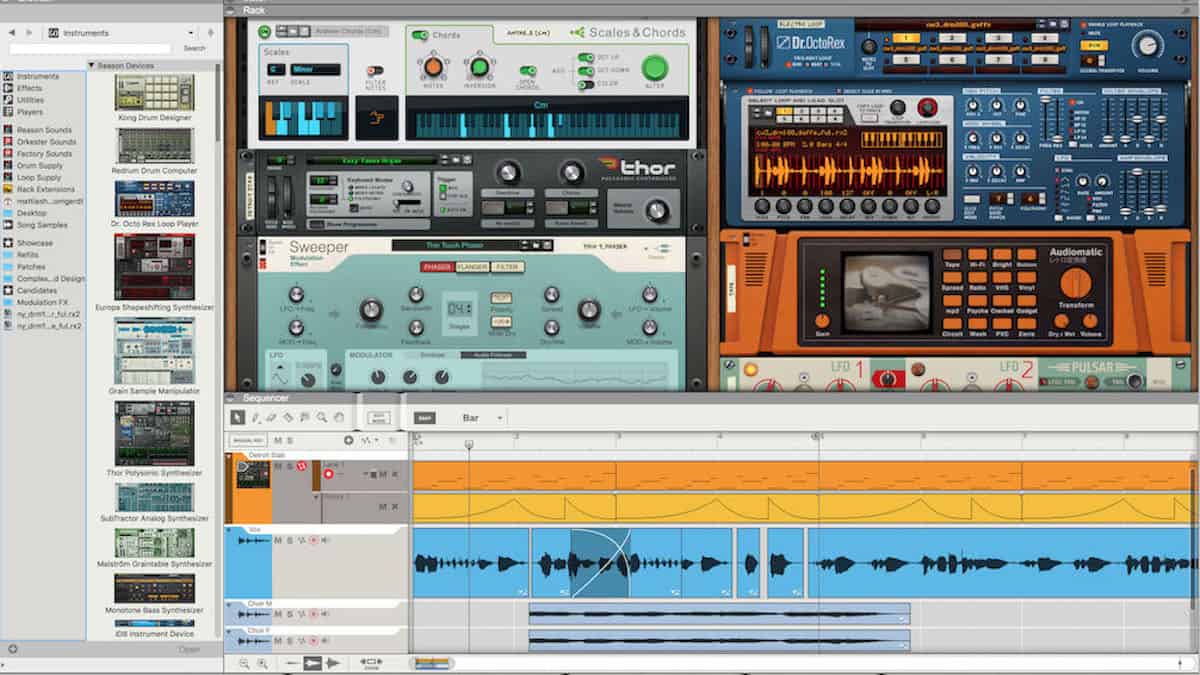Boy, these puns are getting bad, huh?
Reason 11, created by Reason Studios (originally Propellerhead), is a audaciously friendly contribution to the DAW-verse. In addition to being a standalone DAW, it can also be purchased as a plugin for another one!
That effectively doubles your DAW firepower, with the only drawback being that the back-end patching options aren’t available (more on this below).
Offering a minimum of 11 instruments and effects for its essential package ($125 CAD), and going as high as 28 instruments and 31 effects for the full suite ($789 CAD), this DAW is meant to let you hit the ground running.
From when I first started up Reason 11, I was struck by how easy it was to find everything I needed, without a lot of hunting through obscure menus.
The Reason DAW is split into three categories, each with their own dropdown: The mixer, the rack, and the sequencer. The mixer is where final adjustments are made, or where channels are routed. The rack is where the instruments reside. And the sequencer acts as the arrangement view for music-making.
In addition, there is a browser menu, similar to Ableton and other DAWs, where you can check out loop samples, select instruments and effects, and so on. Although I can see the instruments and effects menus becoming a bit bulky with time, it was great to have visuals attached to the names for a relative newbie like myself.
The UI was probably the best I’ve seen so far, with all the key controls obvious and easily accessible. Double-clicking an instrument for example, automatically places it in the rack, and brings up the presets for that instrument in the browser, making it easy to choose something approximating the sound you want.

One significant bummer however, was the browser search only worked within the file currently open. So if I wanted to search for an instrument or effect but the browser was currently showing a loops folder, I had to navigate to the corresponding folder before the search would work.
On the plus side, virtually everything you do can be reversed with CMD+Z, including individual adjustments to the instruments. Yep, every dial turn, button push, or note drag is remembered and can be taken back.

Let’s take a quick look at each of the main windows.
Each channel on the mixer comes with its own EQ and compressor, as well as the usual FX and faders. I found the EQ a bit limited, only allowing 6 points to be adjusted with limited range for each, but at least you can layer them if needed.
The rack was where instrument and FX controls could be played with and patched together. Each one could be collapsed into a single bar – pretty important, as a LOT of scrolling would be required to get to the instrument I’m looking for in a full EDM song. Double clicking the instrument in the sequencer window also brings up the corresponding controls in the rack.
Although I’d heard a major drawback with Reason was they did not support third-party VST hosting, I didn’t experience any issues adding and using some popular free synths (like TuneFish and TAL NoiseMaker) and effects.
One of my favourite features is the envelopes of most of the instruments could be completely automated, by adding and dragging points, adjusting slope, speed, and so on.
A key feature is Reason’s use of sampling to get desired effects. This wasn’t just present in most of the instruments (some of which used really cool techniques like ‘granular wavetable synthesis’), but also in FX features, like the reverb. Each sample waveform can be edited directly, or you can import your own.
Another cool feature for the analog nuts out there, is by pressing TAB, everything flips to the backside showing you their I/O ports, allowing for additional routing options within or even between different modules. A bit too advanced for me, but it looked awesome.

The sequencer gave me a bit more trouble than the other DAWs – there didn’t seem to be as many shortcuts and tools available to quickly add and arrange notes. This was partially offset by Reason’s use of ‘lanes’; allowing tracks to be quickly grouped together under individual instruments or FX simply by dragging and dropping them beside the corresponding channel.
Automation was almost as flexible with Ableton, with nearly every control able to be changed on the fly (the controls that didn’t allow this seemed a bit arbitrary at times). Automation points could also be drawn in with a pencil tool.
As I mentioned earlier, the instrument list was pretty impressive. Reason is known for being a great DAW for EDM artists, so the range of synths didn’t disappoint. But there were plenty of options for other instruments as well. Here’s the ones I tried:
- Kong Kit: A physical modeling sampler, with LOTS of presets. Each sample had its own controls, including 4 FX slots. Up to for variations of each sample can be included in each slot, with 16 slots total.
- Dr. Octo Rex: A sample using Reason’s native REX files. The file samples are sliced up according to their transients, and each transient can be played separately. Sadly there weren’t many presets available for this one.
- Europa Shapeshifting Synthesizer : The most powerful synth I’ve seen since Logic’s Alchemy, this baby sports three wavetables (you heard that right), four envelopes, three LFOs, a modulation matrix… You could have all kinds of fun with this one.
- Grain Sample Manipulator: Uses multiple types of grain synthesis to take literally ANY sound and turn it into something atmospheric or melodic. Very cool.
- Id8 Instrument Device: A basic sampler, with a decent range of high-quality instruments. Four preset controls are allowed per sample.
- Thor Polysonic Synth: A powerful synth, using three oscillators, three filters, two LFOs, and chorus and delay effects. I found the layout rather confusing however, and routing options seemed a bit limited (at least, without using the backside patching controls).
- Subtractor Polyphonic Synth: A subtracting synth with two oscillators, a noise generator, two filters, and three envelopes. Nothing fancy, but easy to use.
- Maleström Graintable Synth: A very unique synthesizer, combining granular and wavetable synthesis together. Lots of presets, including unusual ones like empty bottle, didgeridoo, and even an ear-bleeding recorder sound (for the masochists). Very good for creating weird atmospheric sounds.
- Monotone Bass Synth: A basic bass sound, with a few features like FM, chorus, and delay. I wish pitch and FM had their own envelopes respectively, but I gather you can work around this with back-end patching.
- Klang Tuned Percussion: One of SoundIrons’ fabulous physical modeling samplers, focusing on percussion instruments. There are some beautiful resonance options here, especially with the ‘Circle Bells Mallets’ preset. The layout is very similar to the other SoundIron instruments below.
- Pangea World Instruments: SoundIrons’ second contribution, with even more instruments sampled from a smattering of countries across the globe.
- Humana Vocal Ensemble: The third and final instrument from SoundIron, featuring beautiful voice sampling. Adjustable from a simple duet up to a full choir, and for masculine or feminine voices. Some high-end noise issues with the Mercury and Venus presets, but downright inspiring to work with.
- NN-XT Sampler: A very powerful sampler, able to map samples to a keyboard, with a better range than the drum machines. Additional LFO and other modulation options, and the samples can be grouped together for effects like the Round Robin. Automation is limited for this one unfortunately.
- NN19 Digital Sampler: Reason’s original sampler – not as many bells and whistles, but less confusing to use.
NOTE: I wanted to try the Rytmik Drum Sequencer as well, but it required an additional plugin to work, and I ran out of time on my trial period before I could get to it.
Finally, I also tried out a few of the FX features, and included some more noteworthy ones below:
- The Echo: Lots of cool effects, including a trigger button you can manually activate for some on-the-fly mixing. Includes multiple distortion and wobble effects and an LFO, as well as the usual delay, feedback, and diffuser controls.
- Pulverizer: A distortion engine with impressive dirt and reverb effects.
- Quartet: A gentle chorus engine. You can set the frequency range to be modulated in FFT mode, allowing the possibility for morphing the sound over time.
- RPG-8 Monophonic Arpeggiator: While none of the instruments come with a dedicated arp, any of them can be connected to one of these. Unfortunately it lacks certain basic controls, like swing and gate options.
- RV7000 Reverb: A great-sounding reverb by itself, but can also use uploaded samples as the impulse control for unique sounds. Lots of power over EQ and dampening effects, as well as fine-tuned adjustments that only a sample-based reverb could provide. Easily the best reverb engine I’ve come across so far.
- Sweeper Modulation Effect: Decent power and modulation effects. Can be used as a phaser, a flanger, or for sweeping filter effects.
- Vocoder: Creates a lot of cool effects with samples – you can take one sound and create a very different one with it.
Conclusion: I like Reason 11. A lot. The greedy part of me would rather save and pick up this as an addon to another DAW, even though that limits my patching options. Despite the ‘friendlier’ design, I definitely see Reason becoming increasingly popular in the future.
Photo Credits:
Hammer and bent nails by Pixabay
Numerous wires mounted into server cable tray by Brett Sayles from Pexels
Review Reason Studios Reason by Synth and Software
Three women sitting at an office table with their laptops and talking by Nour Chamoun on Scopio

